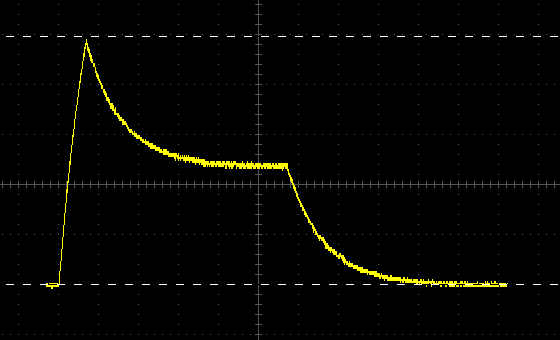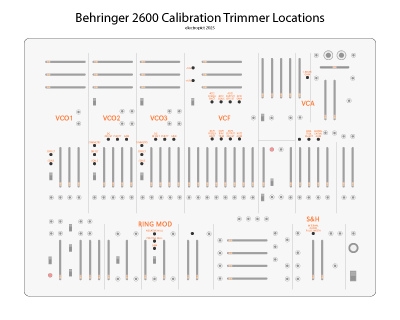Some more notes about the Behringer 2600.
Clocks and Transients
A point which isn’t quite clear either here or in some of the pictures of the ARPs is what the function of the S&H external clock input is. But the later (orange) ARPs clarify that in the panel layout — the jack is an input to the S&H circuit, replacing the internal clock. Consequently it can be used to time the circuit separately while the internal clock is still triggering the transient generators.
Wondering what the actual transient times were, I connected up to an oscilloscope and found that the ADSR attack is surprisingly short in proportion to the other times. This remained the case at all time settings.

I measured the following maxima:
| A | D | R | |
|---|---|---|---|
| ×0·5 | 0·85 | 6·6 | 6·0 |
| ×1 | 2·6 | 22·9 | 19·5 |
| ×2 | 5·4 | 34·4 | 39·0 |
| A | R | |
|---|---|---|
| ×0·5 | 6·35 | 7·9 |
| ×1 | 8·6 | 11·6 |
| ×2 | 17 | 16 |
(Figures in seconds; measurements are to the limit of visibility.)
These measurements are a bit approximate. The highest and lowest voltage levels are reached only very slowly, with probably in most cases the latter half making no audible difference. Nevertheless there is a striking difference between the times on the two circuits.
The peak voltage levels at the generator output were +9·92 (ADSR) and +9·36 (AR). I had a go at checking the minimum times too but observed that it was the length of whatever the gate pulse was that triggered the envelope. Here I noted that both the S&H internal clock and the LFO produce gates rather than trigger pulses at their outputs, with the length varying by frequency. Not surprising, but it does mean that you’d struggle to get a really fast time, although it is still possible to check the minimum attack and decay times.
Waveforms
Neither of these clocks actually generate a clean symmetrical square wave. I compared that to the VCO square waves and found that they’re also quite asymmetric. Indeed, VCO2 & 3 are 100% high when turned about 80% of the way up, and about 25% high when they’re all the way down. There should be a symmetry trimmer in one of the holes on the panel, but it’s not marked. I also looked at the other waveform and found they’re substantially different from the nominal shapes; not just a little curved but well out. The ‘sines’ are almost square, and the triangles and sawtooths seem to be clipped too. Unsurprisingly (it’s not uncommon in analogue synths) the square turns rather triangular at the upper frequency end too. Also, the overall tuning of the VCOs doesn’t go up to 10KHz or even 8·3KHz which is the ARP original setting given in the service manual, but just short of 7KHz. And their low end doesn’t go down to 10Hz either — actually about 13Hz.
Some fiddling with the trimmers can retune the upper end quite a lot of higher but takes the low end with it. The additional trimmer on VCO2 and 3 which is square symmetry in the original doesn’t do anything to fix it, but seems to slightly increase the slopes of the sine wave, i.e. may be dropping the gain, producing less clipping.
Overall, since the Behringer has several additional trimmers compared to the ARP, and some are in different positions or have different functions, I don’t think the ARP service manual is useful as guide to calibration.
Apparently Behringer didn’t bother to produce any calibration information for this unit, but instead put all their money into an ‘app’, which I suspect means a phone/tablet based bit of software, to do something. Which isn’t much use.
Testing it out, I find that the oscillators can produce a very high pitch, up to 56KHz at the limit I can drive it, though by then the waveform has collapsed to a very rounded sawtooth. Still, plenty of headroom.
Overall, I think this needs a complete calibration before I go any further.
Calibration
I managed to find a calibration guide for the Behringer, but it had some errors along the way. So I’ve done this little chart to show the location of the different trimmers.

While going through the process I found there’s something affecting the VCO wave shapes which calibration doesn’t seem to remove. There’s no way (from outside anyway) of correcting the symmetry of VCO1 square wave. And several of the other calibrations can’t be quite carried out because the trimmers don’t go far enough. Most of the trimmers are single-turn and don’t seem to be especially good quality, jumping around a lot. But hey, it was a third of the price of the better quality reproductions. I might consider replacing them at some point. And maybe some of the slidepots.
While trying to find some information about all this I notice that apparently the difference between the ADSR and AR times is largely that the circuits are quite different — the AR is supposedly just a slew limiter, and someone mentioned that Behringer decided to make the ADSR attack shorter. I’m not sure if that was an observation or something with a rationale. Conceivably it could be to make the minimum sound that bit sharper, though given that the transients are triggered by a gate signal and there’s no simple pulse available on-board, that’s probably not the best option?
I did what I could anyway.
And After
Thereafter it was a little improved, and mostly worked, but always took a while to attain pitch stability and intermittently produced significant pitch changes over a period of a few seconds, even between half an hour and an hour on. These changes affected all three oscillators simultaneously and were, as far as I could tell, in perfect semitones. The only circuit element in the thing capable of producing that change would presumably be the MIDI to CV conversion circuit?
I was intending to have a closer look at that when I had time, but as at the time of writing, in the last few days it has been abnormally badly behaved, pitch wavering fairly continuously. Perhaps it was being affected by the Summer heat over the last month, but you wouldn’t think so; this is not a warm climate. Its behaviour has deteriorated significantly and I am intending to attempt a repair, but I’ll leave this page at that point. Look out for part 3 . . .
Comment or Question about this page? write
Article text ©2025 Electropict  .
.
Click images for individual licences.
